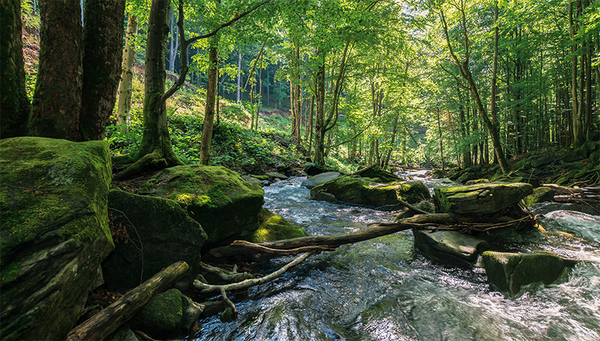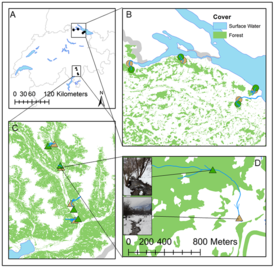News Detail
Sensitive river bugs in the stream benefit from forested banks
March 27, 2023 |
A lot of leaves end up not only on the forest floor, but also in watercourses in autumn. And just like on the forest floor, there are invertebrate river bugs in streams that feed on leaves and other organic material, decompose it or find shelter in it. They are referred to as macrozoobenthos. Among them, for example, amphipods and insects. Alongside microorganisms such as bacteria and fungi. They not only play a key role in the decomposition process, but are also an important food source for fish. Especially the most sensitive species from the order of stoneflies, caddisflies and mayflies only occur in intact stream ecosystems that can fulfil their natural functions.
What role does riparian vegetation play for streams?
It seems obvious that where there is a lot of foliage and other organic material in the stream, there is also more life. “In fact, however, there has been insufficient research to date into how strongly the biotic communities in different sections of streams are influenced by riparian vegetation,” says Rebecca Oester, a doctoral student at the aquatic research institute Eawag. Does it make a difference whether the stream flows through a forest or a meadow? And if so, how does the occurrence and diversity of the macrozoobenthos and the rate at which leaves are decomposed in the stream change? Oester, an aquatic ecologist, investigated these questions in her doctoral thesis as part of a cross-institutional project led by Andreas Bruder, group leader at the University of Applied Sciences of Southern Switzerland SUPSI, and Florian Altermatt, Professor of Aquatic Ecology at Eawag and the University of Zurich.
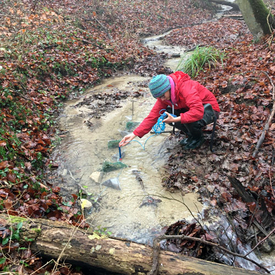
For her experiment, Rebecca Oester placed leaf-filled traps in the stream bed and measured various parameters such as pH and oxygen content of the water.
(Photo: Andreas Bruder, SUPSI)
Over 22,000 organisms counted and determined
From December to January, the most active phase for deciduous macrozoobenthos, Rebecca Oester examined eight watercourses – four on Lake Constance and four in Ticino. These were very small streams with a narrow width and a restricted catchment area. “Very small streams account for the majority of water body kilometres in Switzerland and are thus a particularly important habitat for many living organisms. That is why they are of great interest from an aquatic ecological point of view,” explains Oester. For each stream, she selected one forested and one non-forested stream section and set traps in the water there: coarse-pored nets, which she filled with foliage and into which the river bugs could pass. She left the nets in the streams until about half of the foliage had gone. After she removed the nets, Oester examined their contents in the laboratory to determine the number of creatures, biomass and species. In meticulous work, she examined every single creature under the microscope – over 22,000 in total.
The occurrence and diversity of macrozoobenthos in forested and non-forested stream sections were investigated in eight micro streams in the Lake Constance region and in the Blenio valley in Ticino.
(Graphic: Oester, R. et al., Hydrobiologia, doi.org/10.1007/s10750-022-05049-7)
Sensitive species more common in forested sections
“In some samples I found hundreds of different species. It’s amazing how much life just a handful of leaves makes possible,” says Rebecca Oester. She was also surprised by the number of creatures in the samples that do not feed directly on foliage, such as freshwater mites. She explains it this way: “The forest as riparian vegetation is not only vital for deciduous species, but also for those who find refuge in the foliage or hunt for other very small creatures.” After counting and species identification, a pattern emerged: in the samples from the forested sections, the sensitive species and those specialising in deciduous defoliation appeared in greater numbers and diversity, with the difference being more pronounced in the streams near Lake Constance than those in Ticino. “The riparian vegetation seems to have a particularly large effect on sensitive species,” concludes Rebecca Oester.
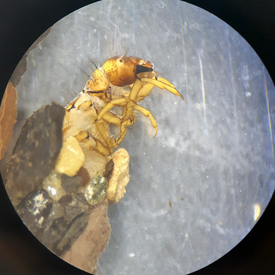
Under the microscope, Rebecca Oester determined the animals from the samples of the examined streams. Here a caddisfly larva
(Photo: Rebecca Oester, Eawag)
As expected, the differences in riparian vegetation also had an effect on the foliage decomposition rate: across all streams, foliage was decomposed around three times faster in the samples from the forested sections. “We didn’t expect such a big difference,” says Oester. “So in the forested stream sections, the leaf-eating organisms were not only more numerous, but possibly also more active.”
Streams benefit from the forest
The findings support the importance of the forest for the biotic communities in streams. Rebecca Oester elaborates: “The forest in the catchment area and in the headwaters is particularly important. The foliage that enters the water bodies also supplies non-forested downstream sections with organic material and nutrients.” Streams therefore benefit when forest is preserved in the riparian area and the vegetation around it is initially targeted during renaturalisation. However: “A row of trees to the left and right along the stream is no substitute for a forest – the leaf input is much greater in a forest,” says Oester.
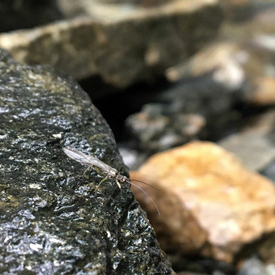
The riparian vegetation has a particularly large effect on sensitive macrozoobenthos such as stoneflies. Their larvae were more abundant in the samples of the forested stream sections than in those of the non-forested sites.
(Photo: Andreas Bruder, SUPSI)
Riparian vegetation: an important factor in the renaturalisation of streams
However, there are still some unanswered questions: why the differences were less pronounced in streams in Ticino. What role different forest communities play. Or whether riparian vegetation has a comparable effect on the macrozoobenthos. Rebecca Oester is investigating the latter in her next project, in which she is looking at aquatic fungi in forested and non-forested sections. A lot of research still needs to be done, says Andreas Bruder from the SUPSI. “If we want to protect or renaturalise streams effectively, we need to better understand the influence of riparian vegetation on the different species groups in the ecosystem and on the food web as a whole.” And Prof. Florian Altermatt adds: “The work shows once again how closely terrestrial and aquatic habitats are linked and how important it is to look at both systems in combination.”
Cover picture: In forested areas, a lot of foliage enters the streams from all sides - with positive effects for the invertebrate river bugs in the water bodies. (Photo: iStockphoto / Mike Pellinni)
Original publication
Funding / Cooperations
- Eawag
- Scuola universitaria professionale della Svizzera italiana (SUPSI)
- Universität Zürich
- Universität Vila Velha, Brasilien
- Schweizerischer Nationalfonds (SNF)

